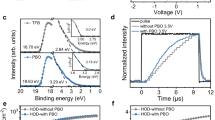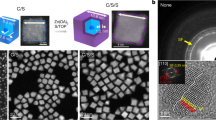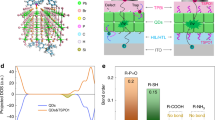Abstract
Quantum-dot light-emitting diodes (QD-LEDs) promise a new generation of efficient, low-cost, large-area and flexible electroluminescent devices. However, the inferior performance of green and blue QD-LEDs compared with their red counterpart is hindering the commercialization of QD-LEDs in display and solid-state lighting applications. Here we demonstrate green and blue QD-LEDs with ~100% conversion of the injected charge carriers into emissive excitons. The key to success is the elimination of electron leakage at the organic/inorganic interface by using hole-transport polymers with simultaneous low electron affinity and reduced energetic disorder. Our devices exhibit high external quantum efficiencies over a wide range of luminance values (peak external quantum efficiencies of 28.7% for green and 21.9% for blue) and excellent stability (extrapolated T95 lifetime is 580,000 h for green and 4,400 h for blue QD-LEDs). We expect our work to provide a general strategy for eliminating charge leakage in solution-processed LEDs featuring organic/inorganic interfaces.
This is a preview of subscription content, access via your institution
Access options
Access Nature and 54 other Nature Portfolio journals
Get Nature+, our best-value online-access subscription
$29.99 / 30 days
cancel any time
Subscribe to this journal
Receive 12 print issues and online access
$209.00 per year
only $17.42 per issue
Buy this article
- Purchase on Springer Link
- Instant access to full article PDF
Prices may be subject to local taxes which are calculated during checkout




Similar content being viewed by others
Data availability
All data that support the plots within this paper and other findings of this study are available from the corresponding authors upon reasonable request.
References
Colvin, V. L., Schlamp, M. C. & Alivisatos, A. P. Light-emitting diodes made from cadmium selenide nanocrystals and a semiconducting polymer. Nature 370, 354–357 (1994).
Coe, S., Woo, W. K., Bawendi, M. & Bulović, V. Electroluminescence from single monolayers of nanocrystals in molecular organic devices. Nature 420, 800–803 (2002).
Qian, L., Zheng, Y., Xue, J. & Holloway, P. H. Stable and efficient quantum-dot light-emitting diodes based on solution-processed multilayer structures. Nat. Photon. 5, 543–548 (2011).
Kwak, J. et al. Bright and efficient full-color colloidal quantum dot light-emitting diodes using an inverted device structure. Nano Lett. 12, 2362–2366 (2012).
Mashford, B. S. et al. High-efficiency quantum-dot light-emitting devices with enhanced charge injection. Nat. Photon. 7, 407–412 (2013).
Dai, X. et al. Solution-processed, high-performance light-emitting diodes based on quantum dots. Nature 515, 96–99 (2014).
Yang, Y. et al. High-efficiency light-emitting devices based on quantum dots with tailored nanostructures. Nat. Photon. 9, 259–266 (2015).
Li, X. et al. Bright colloidal quantum dot light-emitting diodes enabled by efficient chlorination. Nat. Photon. 12, 159–164 (2018).
Shen, H. et al. Visible quantum dot light-emitting diodes with simultaneous high brightness and efficiency. Nat. Photon. 13, 192–197 (2019).
Won, Y.-H. et al. Highly efficient and stable InP/ZnSe/ZnS quantum dot light-emitting diodes. Nature 575, 634–638 (2019).
Kim, T. et al. Efficient and stable blue quantum dot light-emitting diode. Nature 586, 385–389 (2020).
Burroughes, J. H. et al. Light-emitting diodes based on conjugated polymers. Nature 347, 539–541 (1990).
Friend, R. H. et al. Electroluminescence in conjugated polymers. Nature 397, 121–128 (1999).
Kuik, M. et al. 25th anniversary article: charge transport and recombination in polymer light-emitting diodes. Adv. Mater. 26, 512–531 (2014).
Niu, Q., Rohloff, R., Wetzelaer, G.-J. A. H., Blom, P. W. M. & Crăciun, N. I. Hole trap formation in polymer light-emitting diodes under current stress. Nat. Mater. 17, 557–562 (2018).
Tan, Z.-K. et al. Bright light-emitting diodes based on organometal halide perovskite. Nat. Nanotechnol. 9, 687–692 (2014).
Cho, H. et al. Overcoming the electroluminescence efficiency limitations of perovskite light-emitting diodes. Science 350, 1222–1225 (2015).
Yuan, M. et al. Perovskite energy funnels for efficient light-emitting diodes. Nat. Nanotechnol. 11, 872–877 (2016).
Xiao, Z. et al. Efficient perovskite light-emitting diodes featuring nanometre-sized crystallites. Nat. Photon. 11, 108–115 (2017).
Hassan, Y. et al. Ligand-engineered bandgap stability in mixed-halide perovskite LEDs. Nature 591, 72–77 (2021).
Alivisatos, A. P. Semiconductor clusters, nanocrystals, and quantum dots. Science 271, 933–937 (1996).
Talapin, D. V., Lee, J.-S., Kovalenko, M. V. & Shevchenko, E. V. Prospects of colloidal nanocrystals for electronic and optoelectronic applications. Chem. Rev. 110, 389–458 (2010).
Kagan, C. R., Lifshitz, E., Sargent, E. H. & Talapin, D. V. Building devices from colloidal quantum dots. Science 353, aac5523 (2016).
Pu, C. et al. Synthetic control of exciton behavior in colloidal quantum dots. J. Am. Chem. Soc. 139, 3302–3311 (2017).
Arquer, F. P. G. D. et al. Semiconductor quantum dots: technological progress and future challenges. Science 373, eaaz8541 (2021).
Lim, J., Park, Y.-S., Wu, K., Yun, H. J. & Klimov, V. I. Droop-free colloidal quantum dot light-emitting diodes. Nano Lett. 18, 6645–6653 (2018) .
Lee, T. et al. Bright and stable quantum dot light-emitting diodes. Adv. Mater. 34, 2106276 (2022).
Cao, W. et al. Highly stable QLEDs with improved hole injection via quantum dot structure tailoring. Nat. Commun. 9, 2608 (2018).
Pu, C. et al. Electrochemically-stable ligands bridge the photoluminescence-electroluminescence gap of quantum dots. Nat. Commun. 11, 937 (2020).
Chen, D. et al. Shelf-stable quantum-dot light-emitting diodes with high operational performance. Adv. Mater. 32, 2006178 (2020).
Deng, Y. et al. Deciphering exciton-generation processes in quantum-dot electroluminescence. Nat. Commun. 11, 2309 (2020).
Luo, H. et al. Origin of subthreshold turn-on in quantum-dot light-emitting diodes. ACS Nano 13, 8229–8236 (2019).
Su, Q. & Chen, S. Thermal assisted up-conversion electroluminescence in quantum dot light emitting diodes. Nat. Commun. 13, 369 (2022).
Han, M. G. et al. InP-based quantum dot light-emitting diode with a blended emissive layer. ACS Energy Lett. 6, 1577–1585 (2021).
Bässler, H. Charge transport in disordered organic photoconductors. A Monte Carlo simulation study. Phys. Status Solidi B 175, 15–56 (1993).
Sirringhaus, H. Device physics of solution-processed organic field-effect transistors. Adv. Mater. 17, 2411–2425 (2005).
Noriega, R. et al. A general relationship between disorder, aggregation and charge transport in conjugated polymers. Nat. Mater. 12, 1038–1044 (2013).
Karki, A. et al. Unifying energetic disorder from charge transport and band bending in organic semiconductors. Adv. Funct. Mater. 29, 1901109 (2019).
Troisi, A. Charge transport in high mobility molecular semiconductors: classical models and new theories. Chem. Soc. Rev. 40, 2347–2358 (2011).
Wang, L., Li, Q., Shuai, Z., Chen, L. & Shi, Q. Multiscale study of charge mobility of organic semiconductor with dynamic disorders. Phys. Chem. Chem. Phys. 12, 3309–3314 (2010).
Prodhan, S. et al. Design rules to maximize charge-carrier mobility along conjugated polymer chains. J. Phys. Chem. Lett. 11, 6519–6525 (2020).
Qiu, J., Bai, X. & Wang, L. Crossing classified and corrected fewest switches surface hopping. J. Phys. Chem. Lett. 9, 4319–4325 (2018).
Qiu, J., Bai, X. & Wang, L. Subspace surface hopping with size-independent dynamics. J. Phys. Chem. Lett. 10, 637–644 (2019).
Wang, L., Qiu, J., Bai, X. & Xu, J. Surface hopping methods for nonadiabatic dynamics in extended systems. WIREs Comput. Mol. Sci. 10, e1435 (2020).
Sancho-García, J. C. et al. Joint theoretical and experimental characterization of the structural and electronic properties of poly(dioctylfluorene-alt-N-butylphenyl diphenylamine). J. Phys. Chem. B 108, 5594–5599 (2004).
Boudreault, P.-L. T., Beaupré, S. & Leclerc, M. Polycarbazoles for plastic electronics. Polym. Chem. 1, 127–136 (2010).
Kim, J., Kwon, Y. S., Shin, W. S., Moon, S.-J. & Park, T. Carbazole-based copolymers: effects of conjugation breaks and steric hindrance. Macromolecules 44, 1909–1919 (2011).
Rivnay, J., Mannsfeld, S. C. B., Miller, C. E., Salleo, A. & Toney, M. F. Quantitative determination of organic semiconductor microstructure from the molecular to device scale. Chem. Rev. 112, 5488–5519 (2012).
Hwang, J., Wan, A. & Kahn, A. Energetics of metal–organic interfaces: new experiments and assessment of the field. Mater. Sci. Eng. R Rep. 64, 1–31 (2009).
Lange, I. et al. Band bending in conjugated polymer layers. Phys. Rev. Lett. 106, 216402 (2011).
Blakesley, J. C. & Greenham, N. C. Charge transfer at polymer-electrode interfaces: the effect of energetic disorder and thermal injection on band bending and open-circuit voltage. J. Appl. Phys. 106, 034507 (2009).
Blouin, N. & Leclerc, M. Poly(2,7-carbazole)s: structure−property relationships. Acc. Chem. Res. 41, 1110–1119 (2008).
So, F. & Kondakov, D. Degradation mechanisms in small-molecule and polymer organic light-emitting diodes. Adv. Mater. 22, 3762–3777 (2010).
Acknowledgements
We thank X. Peng (Zhejiang University, China) for valuable advice. We also thank L. Jiang (Institute of Chemistry, Chinese Academy of Sciences) for assistance with the UPS analyses. Portion of the work is carried out at beamline 7.3.3 at the Advanced Light Source, Lawrence Berkeley National Laboratory, which was supported by the US Department of Energy, Office of Science, and Office of Basic Energy Sciences. We acknowledge financial support from the National Natural Science Foundation of China (21975220 and 91833303 (Y.J.); 21922305, 21873080 and 21703202 (L.W.)), Key Research and Development Program of Zhejiang Province (2020C01001 (Y.J.)), Guangdong Major Project of Basic and Applied Basic Research (2019B030302007 (L.Y. and F.H.)), Fundamental Research Funds for the Central Universities (2020XZZX002-06 (L.W.)) and China Postdoctoral Science Foundation (2021M702800 (Y.D.)).
Author information
Authors and Affiliations
Contributions
Y.J., together with F.H. and L.W., conceived the idea and supervised the work. Y.D. fabricated the high-performance QD-LEDs, conducted the spectral and electrical characterizations, carried out the optical modelling, and analysed the results under Y.J.’s supervision. F.P. synthesized the high-quality PF8Cz and assisted in analysing the structural properties under the supervision of F.H. and L.Y. L.W. developed the charge-transfer simulation models and performed the theoretical analysis. Under the supervision of L.W., J.D. and J.Q. wrote the main codes of the SPADE software, J.Q. calculated the energy levels of QDs under the effective mass approximation, and Y.L. performed all the DFT calculations and dynamics simulations of the interfacial electron leakage. X.Z. assisted the device fabrication, conducted the optical characterizations, carried out the Kelvin probe measurements and analysed the hole-only devices under Y.J.’s supervision. W.J. assisted in the characterizations of QDs and QD-LEDs. Y.H. assisted in the fabrication of QD-LEDs. Y.G. assisted in the characterization of CdSe-based QDs. T.S. conducted the high-angle annular dark-field scanning transmission electron microscopy and energy-dispersive X-ray spectroscopy characterizations. M.Z. and F.L. conducted the GIWAXS experiments and analysis. D.D. participated in data analysis and provided major revisions. All the authors discussed the results and commented on the manuscript.
Corresponding authors
Ethics declarations
Competing interests
The authors declare no competing interests.
Peer review
Peer review information
Nature Photonics thanks Shuming Chen and the other, anonymous, reviewer(s) for their contribution to the peer review of this work.
Additional information
Publisher’s note Springer Nature remains neutral with regard to jurisdictional claims in published maps and institutional affiliations.
Supplementary information
Supplementary Information
Supplementary Notes 1–3, Figs. 1–17 and Tables 1 and 2.
Rights and permissions
About this article
Cite this article
Deng, Y., Peng, F., Lu, Y. et al. Solution-processed green and blue quantum-dot light-emitting diodes with eliminated charge leakage. Nat. Photon. 16, 505–511 (2022). https://doi.org/10.1038/s41566-022-00999-9
Received:
Accepted:
Published:
Issue Date:
DOI: https://doi.org/10.1038/s41566-022-00999-9
This article is cited by
-
Dipole–dipole-interaction-assisted self-assembly of quantum dots for highly efficient light-emitting diodes
Nature Photonics (2024)
-
Stable and efficient pure blue quantum-dot LEDs enabled by inserting an anti-oxidation layer
Nature Communications (2024)
-
Switchable interfacial reaction enables bright and stable deep-red perovskite light-emitting diodes
Nature Photonics (2024)
-
High efficiency warm-white light-emitting diodes based on copper–iodide clusters
Nature Photonics (2024)
-
High-efficiency inkjet-printed quantum-dot light-emitting diode enabled by solvent-resistant hole transport materials with high surface energy and extended conjugation
Science China Materials (2024)



